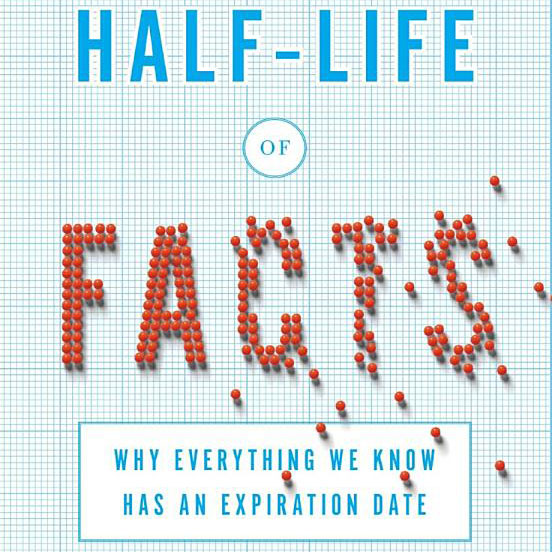I’m excited to share some insights from Samuel Arbesman’s, The Half Life of Facts: Why Everything We Know Has an Expiration Date. It’s important for all of us to know that the information fueling our views and learning is true — and that we can rely on that knowledge when we need it in the future. WE MUST NOT allow politicians, advertisers, and other special interests to teach us that facts are not possible.
We can believe that when we do our work to uncover facts, they will stand the test of time -won’t change unless new insights and evidence demands it. And, hopefully, we can commit to ensuring that information we share is trustworthy: that by sharing we are spreading “truths” that will help people be smarter, make better decisions, and learn more about the world as it is. We don’t want to be spreading fake information.
Facts and factual information are important bases for living our lives, making decisions, and learning. But what ARE facts? And how should we think about them. Are they fixed? Do they change? If they change, how can we trust them? Where do we find facts, and how do they (as well as lies and untruths) spread?
Arbesman, a social network expert and mathematician addresses these questions in his book –a book filled with current and historical examples and stories. We are all participants in this rapidly changing information world, so his insights can help us in our own pursuit of truth andlearning. Here are some of the insights I took away from my reading.
What Is a “Fact?”
Arbesman defines a “fact” as “…a bit of knowledge that we know, either as individuals or as a society, as something about the state of the world. He says that some fields are more precise in what they call facts (physics) because the “facts” refer to something concrete in Nature vs something less tangible, like social behavior. But, a scientist would be careful about conclusions and fact statements in both situations.
And he acknowledges that can facts change over time – with some changing faster than others. He devotes a lot of time showing how facts spread through human networks and how humans “color and distort” information.
What Does This Book Say to Us as Decision Makers and Learners?
Here is what I took away that, hopefully, you will appreciate as a decision-maker and learner:
- Expect “facts” to change – but be wary of making up your own facts. They do change – based on new discoveries, new ways of measuring them. But this doesn’t mean you can change them at whim or because they are inconvenient or don’t fit your embedded view of what is “normal” or how the world “should” be.
- Know how fast knowledge evolves in important areas of your work and life. Facts/knowledge in some fields change faster than others. The rate of change is described in terms of “half-life”—the amount of time it takes for 50% of the knowledge in an area to become obsolete. Know the “half-life” of knowledge in your field (one estimate for engineering is 10 years, for example). It will tell you how vital continual learning is to your ability to stay relevant.
- Be alert to the assumptions that underlie what you say and do. Some opinions you hold may be based on “facts” that are out of date – or opinions that have little grounding in facts.
- Continually renew and revalidate your knowledge in any area. Renew more often if it is a fast-changing area.
- Be careful about the information and conclusions you believe and spread. Even though your views may be “facts” to you, they can be misinformation in the world at large. Share your thoughts as your perspective, experience, opinions, conclusions and desires not “facts.” Know that specific events are probably not universal truths about the world at large. Example: “Animal x is a rabbit. Animal x is bad. Therefore, all rabbits are bad.” You know this is ridiculous, but this type of thinking is very common in our conversations and media today.
- Seek the truth in all you do. Be curious. Be aware of your assumptions and comfort zone. Ask questions and be ready to stand firm when you think the facts warrant it, and to change your mind when they don’t. As a SMART, Unstoppable 4.0 learner, you are entitled to your opinions and beliefs but not to imposing them on others or presenting them as facts. Be a scientist who continually seeks a more accurate view of what is going on and how you can use new knowledge to change your life and add value in the world around you.
Part of being a smart user of information is knowing what constitutes facts/knowledge. Arbesman’s book, The Half Life of Facts helps us here – and we need its insights today more than ever!.
I strongly recommend this book to anyone who wants to be a more discerning citizen and
lifelong learner in these fast changing times.

Samuel Arbesman, The Half-Life of
Facts: Why Everything We Know
Has an Expiration Date. New York:
Penguin. 2013


